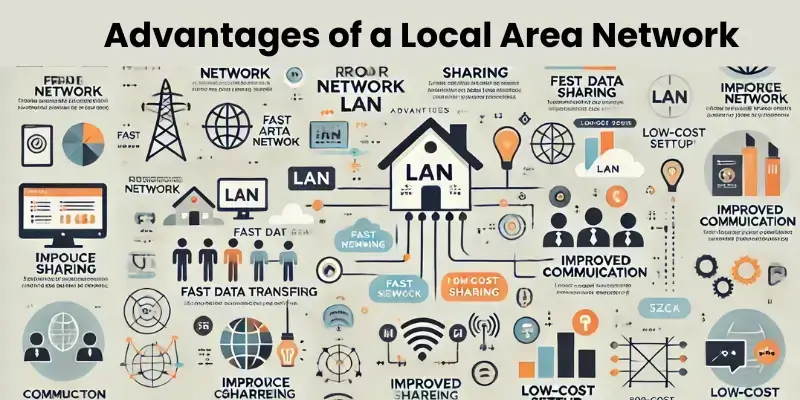Advantages and Disadvantages of a Local Area Network
Published: January 11, 2025
Imagine a busy office where everyone relies on a single network for file sharing, printing, and internet access. That’s the beauty of a Local Area Network (LAN)—it simplifies connectivity. But, like any technology, LANs aren’t without challenges. Let’s explore the advantages and disadvantages of a local area network to understand its role in modern networking.

| What is a LAN? |
|---|
A Local Area Network connects computers and devices in a small area, like a home or office. It makes it easy to share files, printers, and other resources. They can also connect with CANs and PANs to make the network more useful. |
Advantages and Disadvantages of a Local Area Network
Exploring the advantages and disadvantages of a Local Area Network (LAN) helps you understand its benefits, like easy resource sharing, and its challenges, such as security risks. This balance is key to deciding if a LAN suits your needs.
Advantages of a Local Area Network
A LAN offers numerous advantages of using LAN, making it a popular choice for businesses, schools, and homes. It enhances connectivity, simplifies communication, and promotes efficient resource sharing.

Here are some key LAN network advantages:
- Easily Share Resources
- Quick Data Transfers
- Stay Connected
- Simple, Centralized Control
- Save Money
- Work from Anywhere
- Keep Data Safe
1. Easily Share Resources
With a LAN, you can easily share things like printers, scanners, and files between devices, taking full advantage of LAN for efficient resource sharing.
Example: Instead of each person having their printer, everyone in the office can use one shared printer. It saves money and space while making it easier to print documents.
2. Quick Data Transfers
LANs make moving files and data between devices super fast, so you won’t have to wait long.
Example: If a coworker needs to send you a big file, like a 1 GB design, it’s done in seconds, without the slow delays you might get with the internet.
3. Stay Connected
LAN keeps you connected to the network, so you can always access shared files and apps.
Example: In a school, students can access their assignments or class materials stored on the network, and teachers can instantly share updates or announcements with everyone.
4. Simple, Centralized Control
Like an IT manager, one person can control and monitor the whole network from a single place, making things easier to manage.
Example: An office IT manager can ensure all the computers are running the latest software and fix any issues without needing to go to each computer.
5. Save Money
By sharing resources, you don’t need to buy multiple devices or software for each person.
Example: Instead of having their printer, everyone can use one shared printer, cutting equipment costs.
6. Work from Anywhere
LAN lets you access everything you need, even if you’re moving around the office or house.
Example: You can start working at your desk, then move to a meeting room, and still have access to everything, like files or shared apps, no matter where you are.
7. Keep Data Safe
With a Local Area Network, important data is stored on a central server and protected with security measures, which are some of the local area network advantages for keeping data safe.
Example:In a business, all important documents are stored securely on one server, where only the right people can access them. The data is still safe and can be recovered even if someone’s computer crashes.
Disadvantages of a Local Area Network
While LANs offer numerous benefits, they also have drawbacks that can impact their efficiency and usability.

Here are some key LAN network disadvantages:
- Limited Reach and Growth
- Slowdowns with Too Many Users
- Hacking and Virus Risks
- One Failure Affects Everything
- High Setup and Maintenance Costs
- Hard to Share Data
- Lack of Space for Equipment
1. Limited Reach and Growth
LANs are good for small areas like a single office or building, but they’re not meant to cover larger distances. Expanding the network can be tricky and costly.
Example: If a business opens a new branch, connecting it to the same LAN can be hard, requiring expensive upgrades or even setting up a new network.
2. Slowdowns with Too Many Users
One of the disadvantages of the local area network is that when many people use the LAN simultaneously, the network can slow down because everyone shares the same bandwidth.
Example: In a school, if all the students try to access the internet or download files simultaneously, it can cause delays or make the network crawl.
3. Hacking and Virus Risks
A LAN is vulnerable to security threats. If one device gets hacked or infected with a virus, it can spread across the network and affect everything.
Example: If one employee’s computer gets a virus through an email, it might spread to all other connected devices, causing major problems for the company.
4. One Failure Affects Everything
If a key part of the LAN, like the server or central router, breaks, the entire network might stop working.
Example: Imagine your company’s main server crashes. Until it’s fixed, no one can access files, emails, or the internet, causing major downtime.
5. High Setup and Maintenance Costs
Setting up and maintaining a LAN requires a lot of equipment and IT expertise, which can be expensive.
Example: A small business may need to buy server routers and pay for ongoing IT support. Over time, these costs add up, especially as the company grows.
6. Hard to Share Data
Sharing files and data can be tricky if the network isn’t properly set up, and permissions can cause confusion.
Example: If employees don’t have access to shared folders or printers in a company, it can slow down work and cause frustration.
7. Lack of Space for Equipment
LANs require physical space for equipment like servers and routers. In small offices or homes, this can be a problem.
Example: In a small office, finding room for all the networking gear might mean sacrificing space that could be used for desks or meeting areas, making the workplace feel cramped.
Differences between Advantages and Disadvantages of a Local Area Network(LAN)
Here is a difference between LAN advantages and disadvantages:
| Aspect | Advantages of LAN | Disadvantages of LAN |
| 1. Reach and Growth | Connect multiple devices in a small area (office, home, etc.) | It is not ideal for large areas; expanding can be costly and complex. |
| 2. Speed 3. Connectivity | High-speed connections for fast file sharing and communication Enables seamless connection for users within the network | Few users can slow down the network due to shared bandwidth. A failure in a key component (e.g., router, server) can bring down the entire network. |
| 4. Resource Sharing | Devices like printers and storage can be shared easily. | Configured network settings or permissions can make sharing data easier. |
| 5. Security | Centralized control helps secure data and limit unauthorized access | Vulnerable to attacks if proper security is not in place. A single infected device can spread malware. |
| 6. Cost | Sharing resources (e.g., printers, storage) reduces costs | Requires significant upfront investment in hardware and ongoing maintenance. |
| 7. Flexibility | Devices within the LAN can easily access resources from different locations | Network equipment may require physical space, which can be challenging in small offices. |
Wrapping Up
When considering the advantages and disadvantages of a Local Area Network, it’s clear that LANs offer great efficiency and convenience for small spaces like offices and schools. However, weighing the setup costs and security risks before diving in is essential. I recommend starting small and ensuring strong safeguards for optimal performance.
Explore the possibilities of LAN to improve your network’s speed and collaboration. Remember, with the right approach, you can turn challenges into opportunities for growth.
FAQs about Advantages and Disadvantages of a Local Area Network
The advantages of using LAN include easy resource sharing, fast data transfers, and secure communication between connected devices. It’s perfect for small businesses and homes, where everyone can access shared resources like printers and files.
Disadvantages of LAN include limited coverage area, the risk of data breaches, and high setup and maintenance costs. These factors can make LANs less suitable for larger networks or organizations with growing needs.
LAN network advantages and disadvantages help businesses decide if a LAN is the right choice. The fast data sharing and cost savings are big advantages, but security risks and network slowdowns can be challenges.
In schools, local area network advantages and disadvantages include easy access to assignments and shared resources and the potential for slowdowns if too many devices are connected simultaneously.
A Local Area Network (LAN) connects devices within a small area, like a home, office, or school, to share resources locally. On the other hand, a Backbone Network links multiple networks (including LANs) over larger areas, providing high-speed data transfer between them.
For remote workers, the advantages of LAN include easy access to shared files and printers and the ability to work from different locations without losing connection to the network.
The benefits of a local area network include fast data sharing and low costs compared to larger network types like WANs, which can be more expensive and slower.
The advantages of a local area network for home use include better management of shared resources like printers, efficient data transfers, and increased security for all devices connected to the network.
The advantages of using LAN in an office setting include improved communication, centralized file storage, and shared access to resources like printers and internet connectivity, which save time and money.
Multi-factor authentication (MFA) in network security adds an extra layer of security by requiring users to provide two or more verification factors (like a password and a one-time code) before gaining access, reducing the risk of unauthorized access.
The TCP/IP model defines how data is transmitted over networks, while LAN topology specifies devices’ physical or logical arrangement. Together, they ensure efficient data communication within local networks.
The TCP/IP model enables Local Area Network (LAN) communication by handling data transmission, addressing, and routing between devices, ensuring efficient and reliable connectivity.





